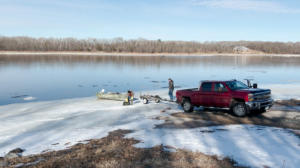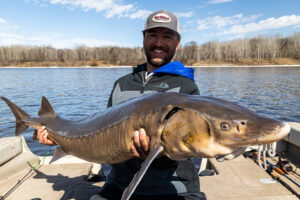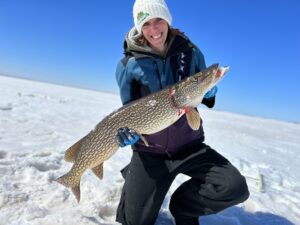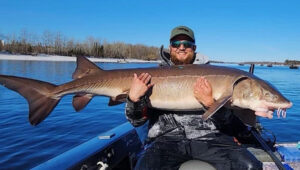Rainy River Sturgeon Fishing Guide:
Unlocking the Secrets of Sturgeon Fishing on the Rainy River and Lake of the Woods

Join us as we delve into the underwater world of the Rainy River in this Sturgeon Fishing Guide and uncover the secrets of the famed lake sturgeon. In this guide, we’ll follow the fish and share the secrets for a grand sturgeon fishing adventure.
Table of Contents
Introduction to the Rainy River on Lake of the Woods
Nestled in the heart of northern Minnesota lies the Rainy River, a haven for anglers seeking the thrill of catching the legendary lake sturgeon. Connecting to the vast expanse of Lake of the Woods, this pristine waterway offers an unparalleled sturgeon fishing experience, particularly during the spring months.
This large US–Canada border waterway stretches approximately 137 miles from Lake of the Woods to the vast network of lakes near International Falls. On the river’s south side sits Minnesota while Ontario is on the North.
Understanding Sturgeon: The Majestic Giants of the Rainy River
Sturgeon, often referred to as the “dinosaurs of the deep,” are an ancient fish species that have inhabited the waters of the Rainy River for centuries. With their distinctive elongated, torpedo-like bodies, bony external plates, flattened snouts and a mouth that can be extended from beneath their head, these majestic giants can grow to impressive sizes, making them a prized catch among anglers.
They rely on extensive shallow waters to hunt for food, using their barbels to lightly probe the bottom in search of prey. Their diet consists of insect larvae, various invertebrates, snails, leeches, small mussels, and tiny fish.
Sturgeon are larger than the more common large fish such as northern pike and muskies. Minnesota lake sturgeon stand out among other large freshwater fish both due to their unique characteristics and ecological significance. Unlike many other freshwater species, sturgeon possess a prehistoric allure, with their long bodies and bony plates (called scutes), and distinctive whisker-like barbels near their mouths.
What sets Minnesota sturgeon apart is their remarkable resilience and longevity; these ancient fish can live for decades and grow to impressive sizes, with some individuals exceeding six feet in length and weighing hundreds of pounds.
Moreover, sturgeon play a crucial role in freshwater ecosystems as indicators of environmental health and contributors to nutrient cycling. Their migratory behaviors, spawning rituals, and ability to thrive in diverse habitats make Minnesota-based sturgeon both fascinating subjects for anglers and vital components of the state’s aquatic biodiversity. Their importance is why they are monitored and protected.
The Minnesota DNR has additional information on the Lake Sturgeon Species Profile.
Migratory Patterns: When and Where to Find Sturgeon
It’s said that the best place to catch sturgeon in Minnesota is called the Four Mile Bay of the Rainy River where it meets Lake of the Woods.
The migratory patterns of lake sturgeon on the Rainy River are a fascinating phenomenon deeply intertwined with seasonal changes and reproductive behaviors of these interesting creatures. Here’s a comprehensive description of their migratory patterns:
Spring Migration:
As winter loosens its grip and temperatures begin to rise, lake sturgeon embark on their spring migration in the Rainy River. Typically starting in late March or early April, as the ice thaws and water temperatures increase, sturgeon that have spent the winter in deeper pools and holes begin to move upstream.
During this time, sturgeon gather near the mouth of the Rainy River, where it meets Lake of the Woods. Here, the fish congregate in preparation for their journey upstream. The warming waters trigger a surge of energy in the sturgeon, prompting them to seek out spawning grounds in the upper reaches of the river.
This is why the River Bend Resort near Baudette is such a great fishing spot for sturgeon in the spring. Our location is right on the sturgeon highway! And we know all the hotspots in their path.
Summer Habitat:
As spring transitions into summer, lake sturgeon settle into their preferred habitats along the Rainy River. Because sturgeon are bottom feeders, scavenging for insects, crustaceans, mollusks, and small fish along the riverbed, they seek out areas with moderate to swift currents, rocky substrate, and ample food sources.
Prime locations for sturgeon during the summer months include deep pools, channels, and eddies where they can find refuge from strong currents and predators. These habitats provide the necessary conditions for sturgeon to thrive and grow throughout the summer season.
Fall Feeding and Migration:
As summer wanes and temperatures begin to cool, lake sturgeon shift their focus to feeding in preparation for the upcoming winter months. During the fall, sturgeon become more active in their pursuit of food, scouring the river bottom for sustenance to build up energy reserves.
In late fall, as water temperatures drop and daylight hours shorten, sturgeon start their migration downstream toward deeper, overwintering areas in Lake of the Woods. They seek out deep holes, channels, and backwaters where they can find refuge from freezing temperatures and ice cover.
Winter Dormancy:
During the winter months, lake sturgeon enter a period of dormancy in the deeper waters of Lake of the Woods. They become less active and conserve energy to endure the cold conditions. Sturgeon rely on their remarkable ability to withstand harsh environments, including low oxygen levels and limited food sources, during this time of year.
Throughout the winter, sturgeon remain relatively stationary in their overwintering habitats, waiting for the return of spring when the cycle of migration and spawning begins anew.
In summary, the migratory patterns of lake sturgeon on the Rainy River are intricately linked to the changing seasons and environmental cues. From their spring migration to their summer habitat, fall feeding, and winter dormancy, sturgeon navigate the waters with purpose, driven by instinct and the rhythms of nature. Understanding these patterns is key to conserving and protecting this iconic species for future generations to enjoy.
Springtime on the Rainy River: A Sturgeon Fishing Paradise
Springtime marks the peak season for sturgeon fishing on the Rainy River near Baudette. As the ice melts and the waterways open up, anglers flock to this northern Minnesota boundary paradise to test their skills against these formidable creatures.
Spawning usually takes place between April and early June. The months of April and May are particularly rewarding, with sturgeon congregating in the shallower waters of the river, making them more accessible to anglers. Conveniently, our sturgeon fishing resort is located right in the area where all of this happens.
In the springtime, there are variables with ice flow and where you can dock. Our resort is in a good position, with a great place to stay and a full bar & grill.
Sturgeon Keep Seasons, Catch & Release, and Sturgeon Limits in Minnesota
There are two “Keep Seasons” or “Harvest Seasons” for sturgeon in Minnesota:
- The Spring Keep Season begins on April 24th and ends May 7th.
- The Summer Keep Season begins on July 1st and ends September 30th.
Sturgeon are protected, but still can be fished with the “catch and release method” outside of these keep seasons, with one exception. The season is closed to any form of targeting sturgeon from May 16th to June 30th.
What is the MN sturgeon limit? There is a protective slot on sturgeon allowing anglers to keep one sturgeon per calendar year with tag, between 45-50 inches inclusive (that means any fish caught under 45” or over 50” must be immediately returned to the water), or over 75 inches in length.
Lake of the Woods and Rainy River anglers often enjoy “The Sturgeon Surprise.” While some anglers target sturgeon during the appropriate seasons, many are caught inadvertently year-round while fishing for walleye.
Other Fish in Rainy River in the Spring
Walleye: The Rainy River and Lake of the Woods are a top spot for Walleye. In fact, the region is often referred to as “The Walleye Capital”. But there are a few rules and regulations for boundary border water walleye fishermen need to be aware of. You can no longer target boundary water walleye from April 15th (same date every year) to the second Saturday in May. That’s when the walleye season opens back up.
Pike: Late season pike spawn in frozen tributaries leading into the bays and shallow breaklines of Lake of the Woods. The Rainy River is a great place to fish northern pike.
Other Fish: The Rainy River also hosts all the common fish of lakes and rivers in the northern Minnesota and boundary water region such as muskie, smallmouth bass, sauger, crappies, yellow perch, and other smaller forage species.
Best Practices for Sturgeon Fishing
When it comes to sturgeon fishing on the Rainy River, patience and perseverance are key. Since they’re bottom feeders, it’s a game of placing yourself in the correct position and waiting for them to find your bait.
These fish are enormous, so utilizing sturdy fishing gear and opting for bait such as nightcrawlers or shad can increase your chances of success.
Additionally, there’s some personal responsibility involved. Practicing catch and release ensures the sustainability of sturgeon populations for future generations to enjoy, so we’ve laid out a few considerations for responsible sturgeon fishing:
- Before bringing a large fish onto your boat, ensure that fishing rods, tackle boxes, and other loose items are secured out of the way. If someone is reeling one in, a good boatmate will tidy up the area.
- Consider using a measuring device attached to the outside of your boat to measure the fish quickly before releasing it, thus avoiding the need to take it out of the water. Some large fish may be too risky to bring aboard a boat; release these big boys without lifting them onto the boat whenever possible.
- Avoid keeping fish out of the water for too long. It’s easy to get excited when hooking a trophy, but please be conscious of how long the fish is above water to help preserve its life.
- It’s not uncommon to fight the fist for longer than 10 minutes. We recommend heavier fishing lines to pull the fish in more swiftly, thus reducing the fish’s stress and exhaustion.
- When photographing a sturgeon, always support it horizontally; refrain from holding it vertically by the head, gills, or tail, even for photos. Get help from your boatmates.
- Never touch a sturgeon’s eyes or gills.
MN DNR Sturgeon Fishing Advice
The Minnesota DNR has additional information on How to Catch Lake Sturgeon and a Lake Sturgeon Species Profile Information Page.
We’ve worked with the DNR and have received some useful tools. First, a PDF document titled: Lake Sturgeon Angler Advice, which covers “Advice on Handling Lake Sturgeon” and “Being Prepared to Fish for Sturgeon.” The information is similar to what we’ve covered above but also has great photos.
We’ve also received information on measuring and documenting a tagged sturgeon, along with a table for measuring the Lake Sturgeon Length-Girth-Weight Relationship, which can also help determine the sturgeon’s age.
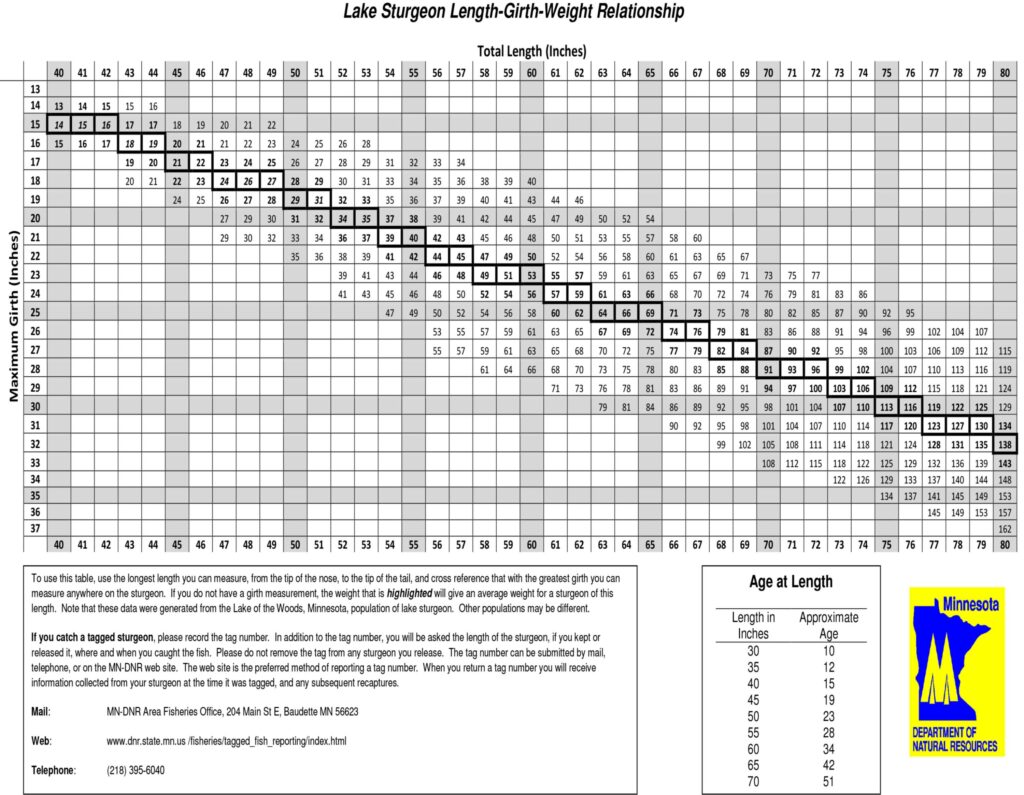
Here's what the document says:
To use this table, use the longest length you can measure, from the tip of the nose, to the tip of the tail, and cross-reference that with the greatest girth you can measure anywhere on the sturgeon. If you do not have a girth measurement, the weight that is highlighted will give an average weight for a sturgeon of this length. Note that these data were generated from the Lake of the Woods, Minnesota, population of lake sturgeon. Other populations may be different.
If you catch a tagged sturgeon, please record the tag number. In addition to the tag number, you will be asked the length of the sturgeon, if you kept or released it, where and when you caught the fish. Please do not remove the tag from any sturgeon you release. The tag number can be submitted by mail, telephone, or on the MN-DNR website. The website is the preferred method of reporting a tag number. When you return a tag number you will receive information collected from your sturgeon at the time it was tagged, and any subsequent recaptures.
Minnesota Sturgeon Fishing Hotspots
We often get asked “where can you fish sturgeon in Minnesota?” In Minnesota, there are several locations where anglers can fish for sturgeon, generally in larger bodies of water. They’re a migratory species that travel extensively and can be found in all drainage systems in Minnesota except the Missouri River basin. They typically inhabit and travel seasonally between moderately clear, spacious rivers, and lakes. Some of the most popular areas include:
- Rainy River: The Rainy River, located in northern Minnesota, is a renowned destination and often said to be the best MN spot for sturgeon fishing. As the river connects to Lake of the Woods near Baudette, Minnesota, it serves as a prime spawning ground for lake sturgeon during the spring months. Note: Our resort is along their migration path on the bank of the Rainy River.
- St. Croix River: The St. Croix River, which forms part of the border between Minnesota and Wisconsin, is another popular spot for sturgeon fishing. Anglers can find opportunities to catch sturgeon in various sections of the river, particularly in deeper pools and channels.
- Mississippi River: Portions of the Mississippi River in Minnesota offer excellent sturgeon fishing opportunities, especially in areas with rocky substrate and deep holes. Anglers can target both lake sturgeon and shovelnose sturgeon in this iconic river system.
- Minnesota River: The Minnesota River, flowing through southern Minnesota, provides anglers with opportunities to catch lake sturgeon in some regions. Focus on areas with slower currents and deeper pools, particularly during the spring and fall seasons.
- Red River of the North: The Red River of the North, which forms the border between Minnesota and North Dakota, is known for its population of channel catfish, but it also offers opportunities to catch lake sturgeon. Anglers can find sturgeon in deeper holes and channels throughout the river.
FAQs: Answers to Your Common Sturgeon Fishing Questions
The spring months of April and May offer prime sturgeon fishing opportunities as the fish migrate upstream for spawning. The best spots are near the mouth of the very large Lake of the Woods which has the deeper waters and is where they spend their winter.
Nightcrawlers and shad are popular bait choices among anglers targeting bottom-feeding sturgeon on the Rainy River. Our guides will share a few other baiting tricks and secrets.
Yes. It’s important to familiarize yourself with local fishing regulations and size limits to ensure compliance and promote conservation efforts. We inform all guests of the restrictions and requirements.
Yes, sturgeon in Minnesota are primarily catch and release. The Minnesota Department of Natural Resources (DNR) encourages anglers to practice catch and release when targeting sturgeon in the state’s waters. Sturgeon populations are carefully managed to ensure their sustainability and conservation. Anglers are advised to handle sturgeon with care, avoid causing unnecessary stress to the fish, and release them back into the water promptly after capture. While there are opportunities for anglers to catch sturgeon, it’s essential to familiarize yourself with local fishing regulations and guidelines, including size limits, seasonality, and any specific catch-and-release policies in place to protect sturgeon populations for future generations. By practicing responsible fishing practices, anglers can contribute to the preservation of sturgeon in Minnesota’s waterways while enjoying the thrill of catching these iconic fish. For more information, ask our agents when you call, or visit the Sturgeon info on Minnesota DNR’s website.
When fishing the river in the spring for sturgeon, it’s essential to have the right equipment to increase your chances of success and ensure a memorable fishing experience. Here’s a list of fishing gear needed for sturgeon fishing on the river in the spring:
- Sturdy Fishing Rod: Choose a heavy-duty fishing rod with enough strength to handle the weight and power of sturgeon. A medium to heavy action rod with a strong backbone is recommended.
- Spinning Reel or Baitcasting Reel: Select a quality spinning reel or baitcasting reel that matches the specifications of your fishing rod. Ensure that the reel has a smooth drag system to handle the strong runs of sturgeon.
- Strong Fishing Line: Use a durable fishing line with a high pound-test rating to withstand the strength of sturgeon. Monofilament, fluorocarbon, or braided lines are suitable options. Consider using line with a test strength of 30 pounds or higher.
- Heavy Sinkers or Weights: Depending on the water depth and current, use heavy sinkers or weights to keep your bait anchored to the riverbed. Egg sinkers or pyramid sinkers are commonly used for sturgeon fishing.
- Strong Hooks: Choose large, sturdy hooks designed for sturgeon fishing. Circle hooks or octopus hooks are popular choices. Ensure that the hooks are sharp and securely attached to your fishing line.
- Bait: Select appropriate bait to attract sturgeon. Common bait options include nightcrawlers, shad, gobies, smelt, and pieces of cut fish. Fresh and natural baits tend to be most effective.
- Landing Net: Have a large, sturdy landing net on hand to safely land and handle sturgeon once they are hooked. Opt for a net with a wide opening and strong netting material to support the weight of the fish.
- Gloves: Wear protective gloves to handle sturgeon safely and avoid injury from their sharp scutes and barbs. Leather or rubber gloves provide a good grip and protection against abrasions.
- Measuring Tape or Ruler: Carry a measuring tape or ruler to measure the length of the sturgeon for size reference and compliance with fishing regulations. Always practice catch and release when necessary.
- Fishing License and Regulations: Ensure that you have a valid fishing license for the area and familiarize yourself with local fishing regulations, including size limits, catch-and-release policies, and any seasonal closures.
- Friends: These lunkers are large. If you land a larger one, you’ll probably need 2-3 people to hold it.
- (Bonus) A Cameraman: Have a good SLR camera (or a cell phone with a great camera) with someone in the boat who knows how to compose great photos. Catching a trophy sturgeon is a lifetime memory,so dress well and brush up on the camera skills because you may want to preserve the memories with some great pics!
Yes, you can certainly bring your boat to the Rainy River for fishing. Our resort on the river offers dock slip rentals on the Rainy River, near Lake of the Woods.
Where to Stay for Fishing on the Rainy River
Thinking of trying sturgeon fishing? Call your buddies or gather the family and come on up to River Bend and we’ll make sure you have a great time. We’ve got sturgeon fishing packages through both our fishing resort and our our Baudette hotel to meet any budget and accommodation preference. Our cabins tend to rent out fast in the spring, so we recommend booking sooner rather than later.
Our charter sturgeon fishing guide partners will help equip you with the proper fishing gear and assist with the best practices so you’ll be well-prepared to enjoy a successful and rewarding sturgeon fishing adventure on the river in the spring.
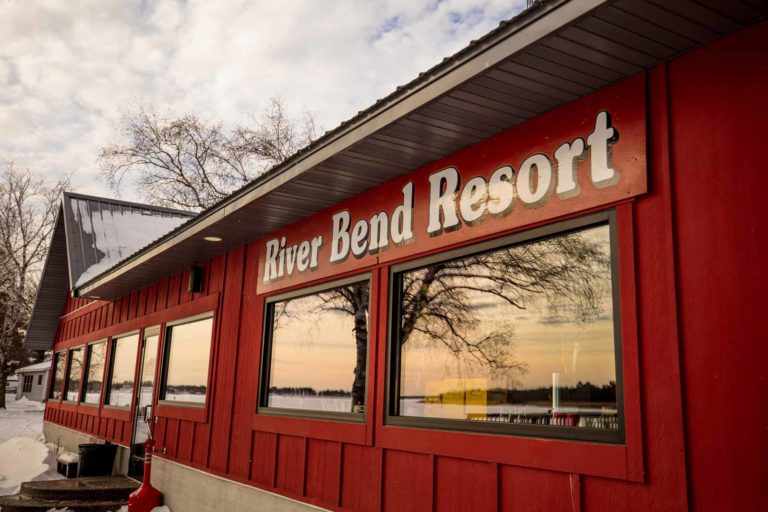
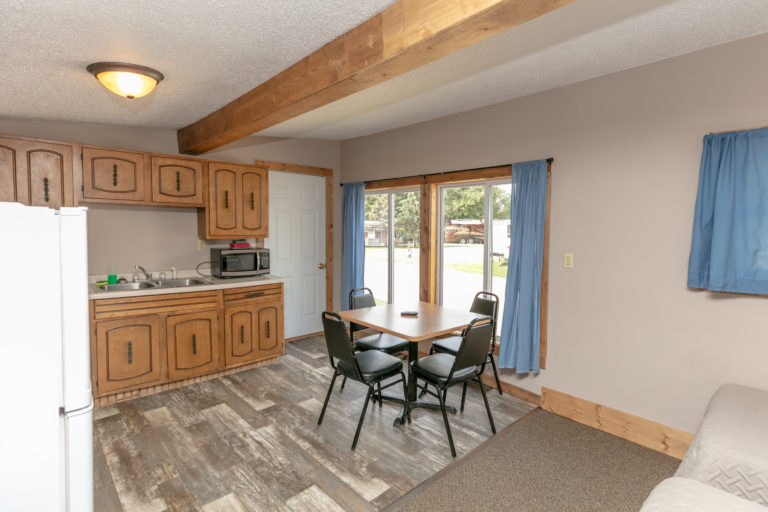




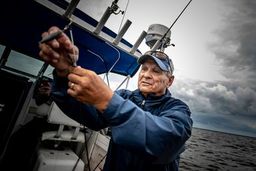

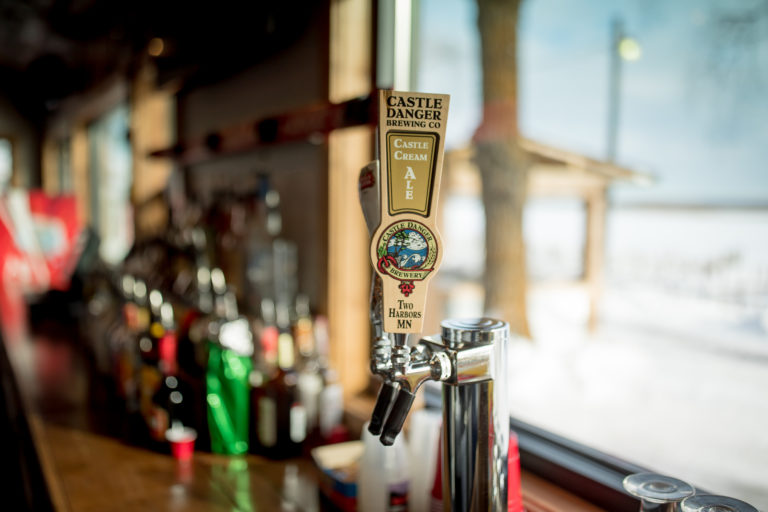
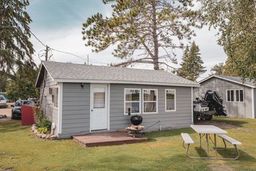

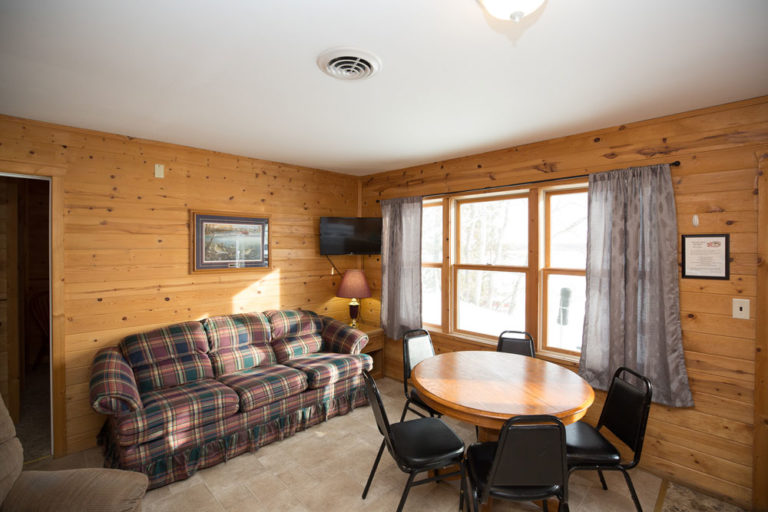
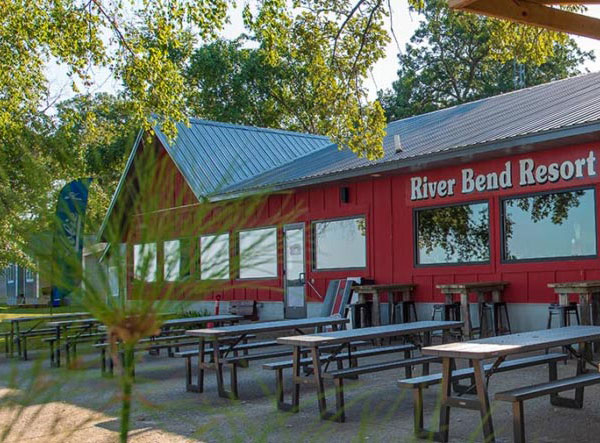
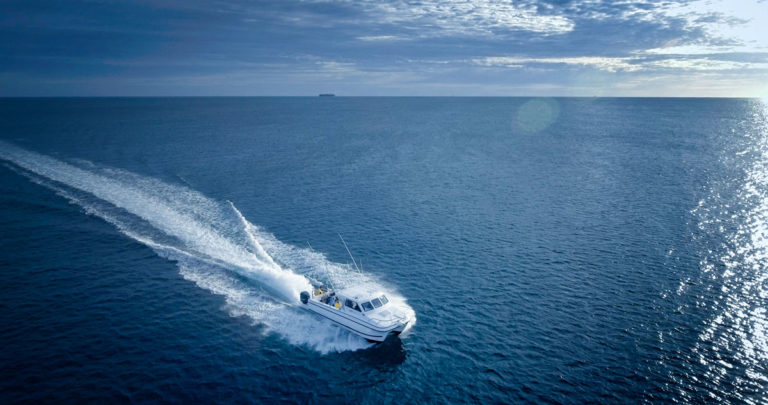
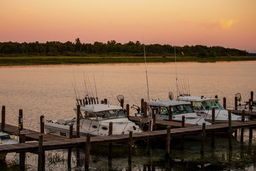
Where can I find Rainy River Fishing Reports?
You can always check our blog which has a section titled “Rainy River Fishing Reports.” Below are the latest posts with relevant reports:
Stay Tuned for More Deals, Discounts, & Fishing Fun!
We offer occasional last-minute deals and discounts to our newsletter subscribers and followers on social media.
Be sure to follow us as well… So the algorithms can serve up our specials!



